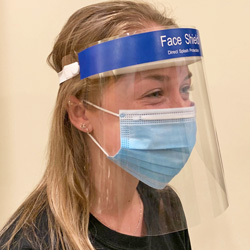To all - In lieu of using the phrase "class size" - use the phrase "occupancy load." This is where not only better professional practice is addressed, but also legal safety standards. Point is - this is more than just about the number of students in the lab - it is the total number of people in there - students, teacher, paras, volunteers, etc. Below are a few avenues to pursue in addressing this issue. Remember this however - it is the teacher that determines if the laboratory is unsafe. It is a double edged sword. Under "duty of care" - if a teacher knows it is unsafe and continues with unsafe lab activities and, a student or other employee get injured - the teacher has JOINT liability issues with the school district. If you believe it is unsafe and the occupancy load is surpassed - do
not carry out labs that are unsafe. Also tell it to the administration in writing as to why it is unsafe. Involve your union if necessary.. Bottom-line is - injury under the teacher's watch knowing it was unsafe is a liability issue - potentially negligence.
OSHA
Legal Standards: As an employee, the
science teacher has the right to a safer workplace. Under
the Occupational Safety and Health Act of 1970, "employers must provide a
workplace free from serious recognized hazards and comply with standards, rules
and regulations issued under the OSHA Act.
In addition, they must examine workplace conditions to make sure they
conform to applicable OSHA standards. (1)"
For science teachers - the OSHA Laboratory Standard (29 CFR
1910.1450) and/or the Hazard Communication Standard (29 CFR 1910.1200) are the
most relevant. OSHA has no jurisdiction
over students. But, because of their numbers and behaviors in
the science lab, it can make for an unsafe working environment resulting from
overcrowding of the space! Science teachers might want to consider
contacting OSHA about the unsafe work environment resulting from overcrowded
conditions, in addition to the other known laboratory hazards.
Fire Codes: Laboratories under the NFPA Life Safety Codes and/or the International
Fire Code have occupancy load limits. The load codes do not dictate the
number of students that a lab can be built for but do prescribe the number of
occupants allowed who can safely exit (get out alive!) the lab. The local
fire marshal in most schools is the "authority of jurisdiction" over the school
district in these matters - not the superintendent of schools! This is similar to auditorium, gyms, etc.
under the jurisdiction of the fire marshal with signage posted. To maintain a safer working environment, the science
laboratory must be analyzed on the basis of determining the design load for
safer exiting capacity. If in doubt, have the "authority of jurisdiction"
assist to determine the occupancy load design of the science laboratory.
Building Codes: The International Code Council or regional code associations
like BOCA (prior to 2003) also sets occupancy loads for academic science
labs. Teachers need to check with local building officials or building
prints to determine the loads which science labs were designed to accommodate.
Professional Standards/Best Practice: Although quasi-legal - they are now
considered at almost equal weight with legal standards in the courts. Science
teachers need to go to NSTA.org and check out the position papers dealing with
safety. Professionally - they
recommend no more than 24 students providing the occupancy load can accommodate
them. Remember the occupancy load depends on the size of the lab, number
of exits, hazards and more relative to the fire and building codes. The NSTA position papers (2) which address occupancy
loads include: Liability of Science
Educators for Laboratory Safety http://www.nsta.org/about/positions/liability.aspx, and Safety and School Science
Instruction http://www.nsta.org/about/positions/safety.aspx.
"Duty of Care" Legal Requirement: As a
professional, the science teacher also has what is known legally as "Duty
or Standard of Care." The teacher must secure a safer instructional
environment for students and other employees. Science teachers and school
administrators have potential liability issues if certain types of experiments
are conducted in a lab which they know are over the occupancy load. Until the occupancy load issue is addressed,
the teacher must consider in earnest cutting back or eliminating any activity
which could be unsafe for him/her selves and students until the instructional
space meets the occupancy load - not surpassing it. Knowing the safety rules (including
appropriate occupancy load factors) and blatantly disregarding them could be
construed as reckless or willful misconduct. Normally for acts of simple or ordinary
negligence, science teachers in most states and towns are covered under the
sovereign immunity principal. However,
if a science teacher's conduct is deemed willful or reckless, then the state or
town may not be required to pay for the defense or the resulting money damages.
I have written on this issue several times in The Science Teacher (Safer Science) and Science Scope (Scope on Safety). Check the NSTA online store or your older NSTA journal copies if you have them.
Hope this helps!
Dr. Ken
Kenneth R. Roy, Ph.D.
Chief Science Safety Compliance Consultant/Author/Columnist
National Science Teachers Association
Please note: The information contained in this email message may be confidential, proprietary, and/or legally privileged information intended only for the use of the individual or entity named above. If the reader of this message is not the intended recipient, you are hereby notified that the copying, or distribution of this communication is strictly prohibited. If you have received this communication in error, please immediately notify the sender by telephone at the above number. Thank you.
Another angle to consider is the NFPA occupancy load regulations for science labs.
